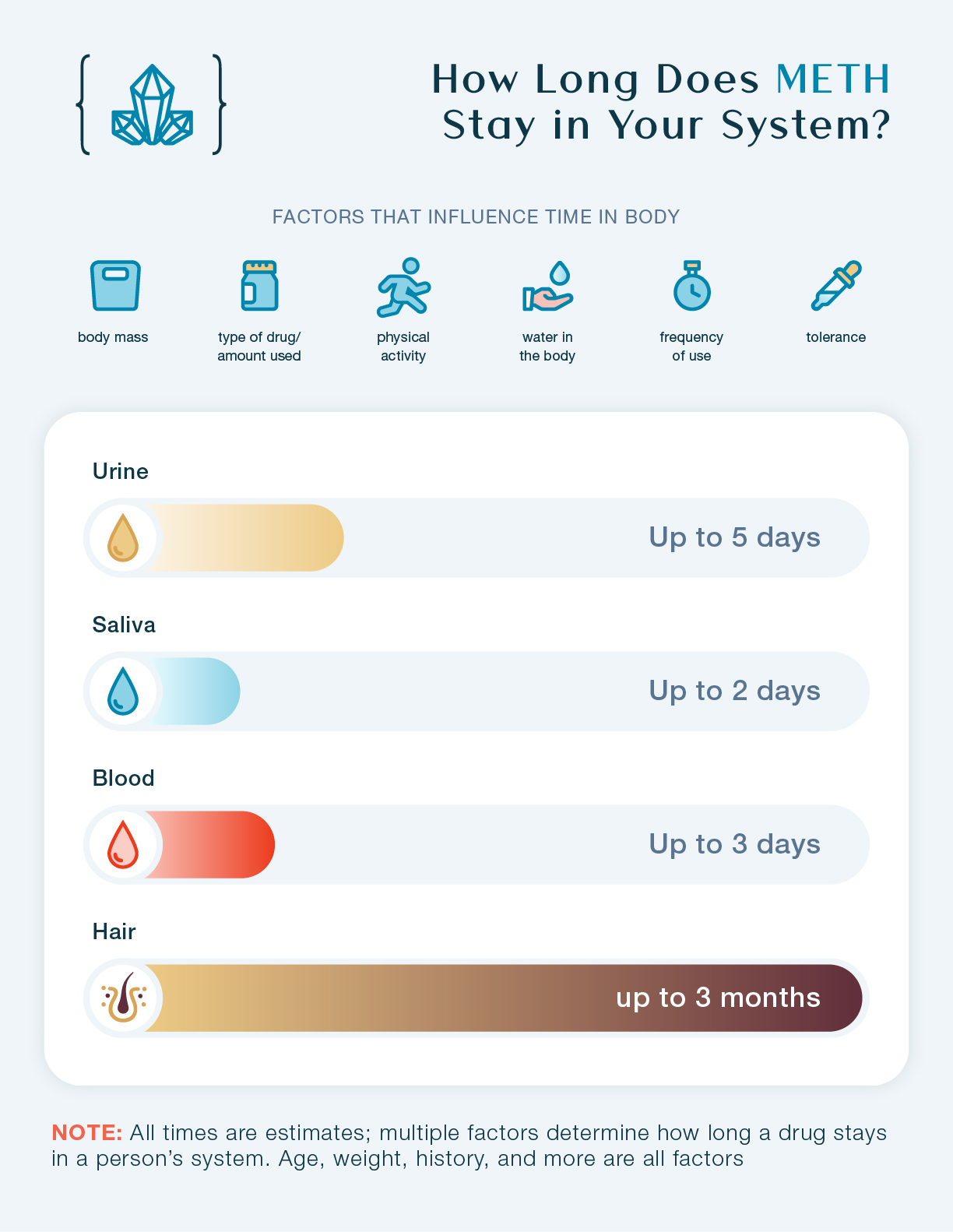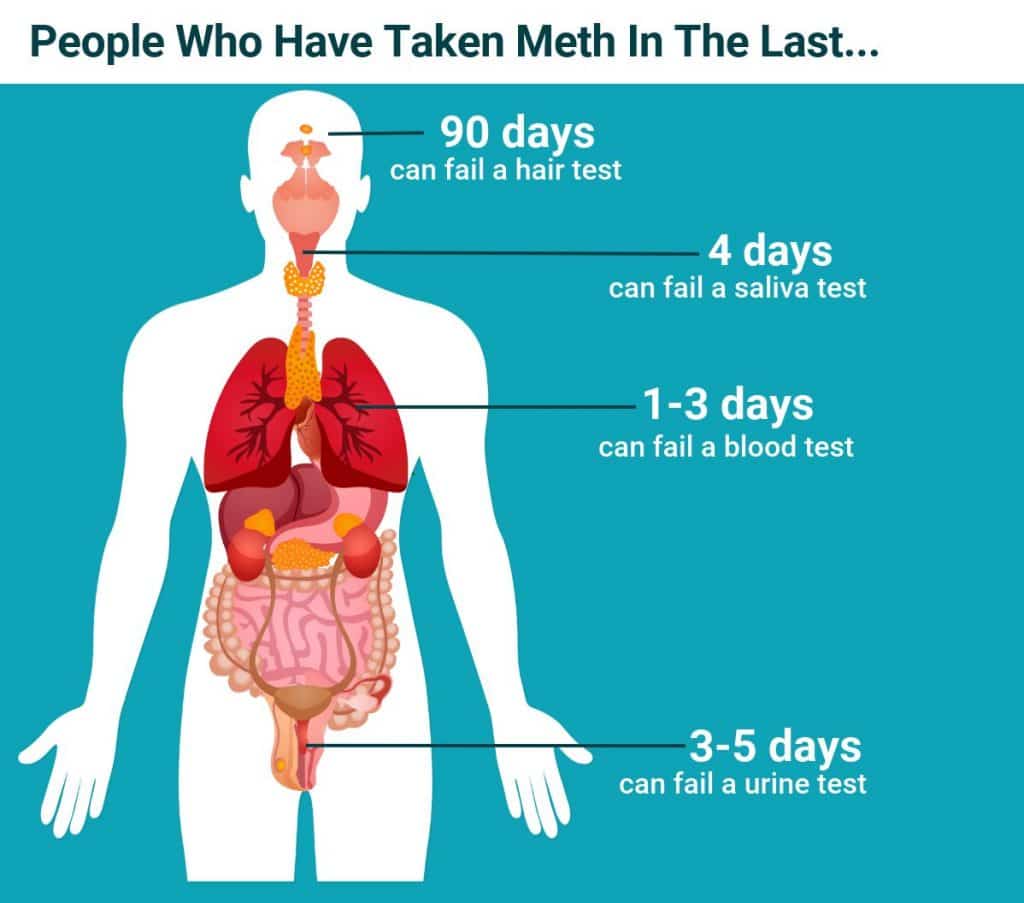Meth can be detected in urine for up to 3-5 days, depending on various factors. Methamphetamine, commonly known as meth, is a potent stimulant that can have lingering effects on the body.
Understanding how long meth stays in urine is crucial for drug testing purposes and overall health considerations. Factors such as frequency of use, metabolism, hydration levels, and individual differences can influence detection times. By knowing the typical window of detection for meth in urine, individuals can make informed decisions regarding drug use and testing protocols.
This information is valuable for employers, healthcare providers, and individuals seeking to maintain a healthy lifestyle free from substance abuse.
Introduction To Meth Detection
Meth can be detected in urine for up to 3-5 days post-consumption. Factors like metabolism and hydration levels influence detection window. Regular use may extend the detection period.
Methamphetamine, commonly known as meth, is a highly addictive and potent stimulant drug that affects the central nervous system. Meth can stay in the body for varying lengths of time depending on several factors, including the dose, frequency of use, individual metabolism, and the type of drug test used for detection. Understanding meth detection is crucial for individuals who have used meth or are undergoing drug testing for various reasons, including employment, legal issues, or addiction treatment.
Factors Influencing Detection Times
Several factors can influence how long meth stays in the urine and other body fluids, including blood, saliva, and hair. The primary factors that determine meth detection times include:
- Dose and frequency of use: The amount of meth consumed and how often it was used can affect how long it remains detectable in the body.
- Individual metabolism: Metabolism plays a significant role in the elimination of meth from the body. People with a faster metabolism tend to eliminate meth more quickly than those with a slower metabolism.
- Body mass: People with higher body mass tend to store more meth in their fat cells, leading to longer detection times.
- Method of use: The method of ingestion also plays a role in meth detection times. Smoking or injecting meth can result in faster absorption and elimination rates, leading to shorter detection times.
- Hydration: Drinking plenty of fluids can help flush meth from the system, leading to shorter detection times.
Importance Of Understanding Meth Metabolism
Meth metabolism plays a crucial role in determining how long the drug stays in the body and how it affects different individuals. Methamphetamine is broken down in the liver and excreted through the kidneys and urine. The primary metabolite of meth is amphetamine, which can also be detected in urine and other body fluids. Understanding how meth is metabolized is essential for interpreting drug test results accurately and determining the level of drug use.
In conclusion, understanding meth detection and metabolism is crucial for individuals who have used meth or are undergoing drug testing for various reasons. Factors such as dose, frequency of use, individual metabolism, and hydration levels can influence how long meth stays in the urine and other body fluids. Meth metabolism plays a crucial role in determining how long the drug stays in the body and how it affects different individuals.
What Is Meth?
Methamphetamine, commonly known as meth, is a powerful and highly addictive stimulant that affects the central nervous system. It is classified as a Schedule II drug, meaning it has a high potential for abuse and is available only through a nonrefillable prescription. Meth can be taken orally, inhaled, smoked, or injected, and its effects can be felt rapidly, leading to a surge in energy and alertness.
Chemical Properties
Methamphetamine belongs to a class of drugs known as amphetamines, which are synthetic substances that stimulate the central nervous system. The chemical structure of meth is similar to amphetamine, but it has a more potent effect on the brain. Meth is typically found as a white, odorless, crystalline powder that can easily be dissolved in water or alcohol.
Effects On The Human Body
Methamphetamine exerts its effects by increasing the levels of dopamine in the brain, leading to a sense of euphoria and increased energy. However, prolonged use of meth can have devastating effects on the body, including severe dental problems, extreme weight loss, skin sores, and increased risk of infectious diseases. Long-term use can also lead to mental health issues such as anxiety, confusion, insomnia, and violent behavior.
Typical Duration Of Meth In Urine
Methamphetamine, commonly known as meth, is a highly addictive stimulant drug. It is important to understand how long meth stays in urine as it can be detected through urine drug tests. The duration of detection can vary depending on several factors, including the amount and frequency of meth use, individual metabolism, and other variables.
Average Detection Window
How Long Does Meth Stay in Urine? On average, meth can be detected in urine for approximately 2-4 days after last use. This detection window may vary depending on individual factors. It is important to note that the drug can be detected in urine for longer periods in heavy or chronic users compared to occasional users.
Variability In Excretion Rates
The excretion rates of meth can vary from person to person. Some individuals may eliminate the drug from their system faster, while others may take longer. Factors such as age, body composition, liver and kidney function, and overall health can influence how quickly the body metabolizes and eliminates meth from urine.
It is crucial to consider that the duration of meth detection in urine is just an estimation, and individual results may differ. Additionally, certain urine drug tests may have different detection thresholds, which can affect the accuracy of results.
In conclusion, while the typical duration of meth in urine is around 2-4 days, it is important to consult with a healthcare professional or a toxicology expert for accurate information regarding drug detection periods. Understanding the typical duration of meth in urine can help individuals make informed decisions regarding drug testing and rehabilitation programs.
Testing Methods For Meth
When it comes to testing for methamphetamine use, different methods can be utilized to detect its presence in the body. The testing methods for meth include urine drug tests, hair follicle tests, blood tests, and saliva tests. In this section, we will focus on the urine drug tests, a commonly used method for detecting methamphetamine in the body.
Urine Drug Tests
Urine drug tests are one of the most common methods used to detect the presence of methamphetamine in the body. These tests are often conducted in various settings, including workplaces, rehabilitation centers, and law enforcement agencies. The process involves collecting a urine sample from the individual and then analyzing it to determine the presence of methamphetamine and its metabolites.
Comparing Test Sensitivities
When comparing the sensitivities of different urine drug tests for methamphetamine, it’s essential to consider factors such as the detection window, cutoff levels, and accuracy. Some tests may have a lower detection window, making them suitable for detecting recent methamphetamine use, while others may have a longer detection window, allowing for the detection of methamphetamine use over a more extended period.
Factors Affecting Meth Clearance
Methamphetamine, commonly known as meth, is a highly addictive stimulant drug that can stay in your urine for varying periods of time. The duration of meth clearance from your urine depends on several factors, including your metabolic rate, hydration and fluid intake, and body mass and health. Understanding these factors can help you estimate how long meth may be detectable in your urine.
Metabolic Rate
Your metabolic rate plays a crucial role in the clearance of meth from your urine. Metabolism refers to the chemical processes that occur within your body to convert food and substances into energy. Individuals with a higher metabolic rate tend to eliminate drugs, including meth, from their system more quickly.
Hydration And Fluid Intake
The amount of water you consume and your overall hydration levels can impact the clearance of meth from your urine. Staying well-hydrated by drinking plenty of fluids can help flush out toxins and drugs from your body. On the other hand, dehydration can slow down the elimination process and prolong the detection window.
Body Mass And Health
Your body mass and overall health condition can influence how long meth remains detectable in your urine. Individuals with a higher body mass may retain drugs in their system for a longer period compared to those with lower body mass. Additionally, factors such as liver and kidney function can affect the processing and elimination of drugs from the body.
It’s important to note that these factors are not the only determinants of meth clearance from urine. Other variables, such as the dosage and frequency of meth use, can also impact the detection window. If you have concerns about meth detection in your urine, it is always best to consult with a healthcare professional or a drug testing expert.

Credit: www.theedgetreatment.com
Impact Of Usage Patterns On Detection
Detection of methamphetamine usage through urine tests can be influenced by individual usage patterns. Understanding how long meth stays in urine is crucial for accurate detection. Factors such as frequency and amount of use play a significant role in determining detection windows.
Impact of Usage Patterns on Detection When it comes to detecting methamphetamine use through urine testing, understanding the impact of usage patterns is crucial. Factors such as frequency of use and dosage considerations play a significant role in determining how long meth stays in urine and can be detected.
Frequency Of Use
The frequency of methamphetamine use directly influences the detection window in urine. Regular users may have a longer detection period, while occasional users might have a shorter window.
Dosage Considerations
The amount of methamphetamine consumed also affects detection. Higher dosages can lead to a longer detection window, while lower doses may result in a shorter period of detection. In conclusion, understanding the impact of usage patterns on methamphetamine detection in urine is essential for accurate testing and interpretation of results.
Legal And Employment Implications
Meth can be detected in urine for up to 3-5 days after use, with chronic users testing positive for longer periods. Employers may conduct drug tests as part of pre-employment screening or during employment, and positive results can have legal and employment implications, including potential termination or legal action.
Workplace Drug Policies
In many workplaces, drug testing is a standard procedure.
Employees can be subject to random urine tests.
- Employers have the right to enforce drug policies.
- Positive results can lead to disciplinary actions.
Legal Consequences Of Positive Tests
Positive drug tests can have serious legal implications.
Employees may face termination or legal consequences.
- Legal implications can vary by state laws.
- Employment may be at risk with positive results.

Credit: www.therecoveryvillage.com
Detoxification And Cleansing Myths
Common Detox Myths
Detox myths can mislead individuals seeking accurate information.
- Drinking excessive water eliminates meth from urine.
- Exercise speeds up the removal of meth from the body.
- Home remedies like cranberry juice can cleanse urine in a day.
Scientifically Proven Cleansing Methods
Verified methods offer safe and effective ways to detoxify.
- Hydration: Drinking water helps flush meth out of the system.
- Diet: Consuming fruits and vegetables aids in the cleansing process.
- Professional Detox Programs: Medical assistance ensures a thorough detox.

Credit: freebythesea.com
Frequently Asked Questions
How Long Does Meth Stay In Urine?
Meth can be detected in urine for up to 72 hours after last use. However, this timeframe can vary depending on factors such as the individual’s metabolism, frequency of use, and the amount of meth consumed. It’s important to note that certain drug tests can detect meth use for a longer period, so it’s best to consult with a medical professional for accurate information.
Conclusion
After analyzing the factors that affect how long meth stays in urine, it is clear that there is no straightforward answer. However, it is generally agreed that meth can be detected in urine for up to 3-5 days after use.
It is important to note that individual factors such as age, weight, and metabolism can impact the detection window. It is also crucial to seek professional help if struggling with meth addiction. Proper treatment and support can lead to successful recovery.


